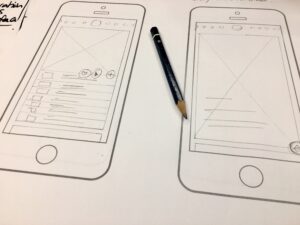Wireframing is a UX (User Experience) design technique that allows designers to establish and arrange the information hierarchy of a website, app, or product.
Based on the user research conducted by the UX design team, this approach focuses on how the designer or client wants the user to digest information on a site. They are devoid of common elements such as images, colors, and text. Instead, they educate the consumer about the following design elements:
- List of the items that will be displayed in the final UI (User Interface).
- The elements are tentatively placed.
- The user interface’s operation.
- Proposed user interaction with the application and/or website elements.
1. Tips for Writing Wireframes
The following considerations should be at the forefront of your thoughts as you construct your wireframe:
1.1Be Clear
Your wireframe should answer the following questions: what is that site page, what can the user do there, and if it meets their needs. Your wireframe is a tool that helps you visualize the structure of your website page and ensures that the user’s most critical concerns are answered and that the user’s goals are met without being distracted by more aesthetic considerations.
1.2 Keep it Simple
Keep the wireframes simple and don’t get carried away. Initially, there is no need to embellish or add graphical components. Colour and bevel effects, for example, are distracting and will lead to a conversation about low-priority items.
1.3 Make a Detailed Sketch

Your wireframe should be a visual representation of your site’s structure and navigation.
1.4 Innovate
Never be afraid to try out alternative layouts. When you go outside the box and create inventive wireframes, you’re more likely to come up with superior ideas.
1.5 Empathize with the User
Consider the user’s point of view and produce a design that meets the needs of your target audience.
1.6 Feedback on a Regular Basis
Work smart and don’t reveal details right away. To gain some early input, show the first draft to your co-workers and clients.
Simply follow the simple steps – Communicate the basic concept > gather feedback from stakeholders > iterate until all needs are met.
1.7 Add Interactions early on
Even though prototypes are used to physically test interactions, wireframes must still have interactions. These are critical for usability testing and UI design efficiency. A wireframe without a visual representation of how it all fits together is just a collection of photos with no clear plan. However, we recommend that you design the images first and then add the interactions. When you discover a new action that is lacking, you add the page until it is complete.
2. What is Wireframing Process?
2.1 Brain Storming

You must research what users require and desire in order to design good wireframes. At the same time, it’s critical to think about the company’s objectives in order to secure product success. Before you start wireframing, do some research to make sure you have a clear idea of what you want to achieve.
2.2 Sketching the Core Elements

You’ll need to visualize your app’s essential elements once you’ve defined the user flow. Sketch the main stages that form the user’s interaction. These would be the entry point, steps to completion, and final interaction.
Sketching this type of path for each desired user activity is a quick and straightforward approach to seeing the user flow thoroughly.
2.3 Set a Mobile Frame
While a simple rectangle can be used as a frame for your mobile design, it’s much better to choose a frame that matches the proportions of the device you’re designing for. The frame, for starters, will operate as a natural limit, preventing you from cramming too many objects onto the screen. Second, a frame will provide the appearance of a real design.
2.4 Determining Layout with the Boxes
Your goal in the early phases of wireframing is to establish a clear visual hierarchy — a defined layout and structure. You shouldn’t be thinking about the content at this point; instead, you should be thinking about how it’s presented. Start by drawing boxes on the canvas to plan the layout based on how you want your user to process the information. Put a lot of thought into the order in which you want to display information to your users. People scan web pages and phone screens from left to right, from top to bottom (an F-shaped pattern works both for desktop and mobile screens).
2.5 Refining & Finalizing
Return to the wireframe and apply any final touches once you have a good sense of how it should look. You can also make an electronic version to utilize throughout the development of your app! It’s critical to make sure everything works properly, so start trying out different functionalities.
If there are issues with how elements seem or operate, consider doing another round of brainstorming, wireframing, and planning until the issues are resolved.
Conclusion
The ultimate purpose of wireframing is to determine the content’s outline and lay a solid basis for subsequent design phases. Wireframes that are well-designed make visual and interface design much easier. Spend enough time playing with different tools and techniques, just like you would with any other design activity, and you’ll develop your own wireframing style.
TechDel is the best mobile app development company based in London. We have a team of talented developers and designers who specialize in producing exceptional UI/ UX design that helps your business thrive. For more details, please visit TechDel UI/UX design Services.
We’d be pleased to answer any questions you have about geofencing and how it may benefit your business. For further information, please Contact Us.


